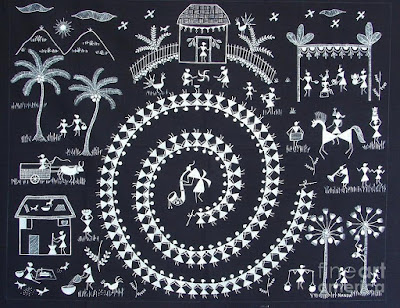WARLI: A quintessential tribal folk art of Maharashtra
Tribal
communities have contributed enormously in developing a rich heritage of our
country as well as sustaining their tangible and intangible culture hence, it
is really important to understand their cultural milieu as they are prominent
section of the society. Every tribal
hamlet in India owns a significant art and skills and is enriched with diverse
traditions and folklore. One of all the
tribal arts is Warli, inherited from the indigenous tribal community of
Adivasis residing in the Indian state of Maharashtra, Gujarat and enclosing
areas.
Warli is a
traditional folk-art of Maharashtra which is created collectively by 2 to 10
tribal married women, called as Suhasini within their community. Warli painting
is different from other folk painting traditions of India in many important
aspects. They don’t narrate mythological stories like the Madhubani paintings
of Mithila do. On the contrary they depict social life and daily events.
According to
Jivya Mahse, a best international artist from Maharashtra, Warli tribal art
form was popularized in the seventies by him under the intelligence of social
worker, Bhaskar Kulkarni.
The people of
Warli tribe sing and dance on the tunes of Tarpa, a musical instrument which is
depicted in these paintings.
There is no use
of myriad primary colors whereas only rice paste is used as a medium in this
art, hence Warli paintings are distinguished.
The prime idea
in these traditional art paintings is surrounded by the scenes showing hunting,
fishing and farming, festivals and dances, trees and animals etc. This
authentic art is still practiced by the Warlis on the walls of their huts in
the rural areas of Maharashtra.
The designers
were very enticed through this ritualistic art form that they created different
dresses based on this art.



Lovely post! Warli Art tells stories of Indian tradition through simple yet powerful designs. Vibecrafts has a stunning range of Warli paintings that bring an ethnic and artistic touch to any modern living space.
ReplyDeleteIf you appreciate authentic Indian artistry, you’ll love the Warli Art collection from VibeCrafts. Each piece combines traditional motifs with modern elegance — perfect for home or office décor!
ReplyDeleteI recently discovered VibeCrafts’ warli art collection, and it’s absolutely stunning! The intricate designs beautifully capture India’s tribal heritage while adding a modern touch to any space. Perfect for cultural home décor!
ReplyDelete